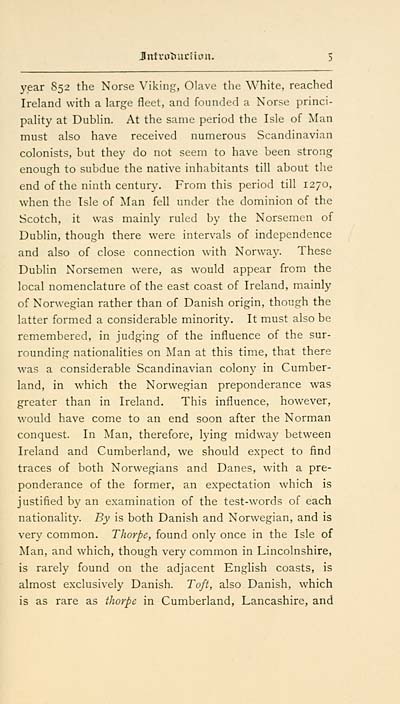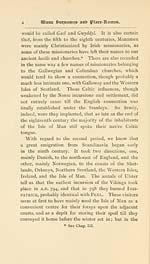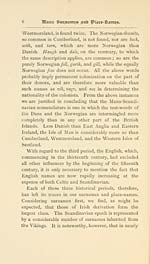Download files
Complete book:
Individual page:
Thumbnail gallery: Grid view | List view

Jntra^ucH0^.
year 852 the Norse Viking, Olave the White, reached
Ireland with a large fleet, and founded a Norse princi-
pality at Dublin. At the same period the Isle of Man
must also have received numerous Scandinavian
colonists, but they do not seem to have been strong
enough to subdue the native inhabitants till about tlie
end of the ninth century. From this period till 1270,
when the Isle of Man fell under the dominion of the
Scotch, it was mainly ruled by the Norsemen of
Dublin, though there were intervals of independence
and also of close connection with Norway. These
Dublin Norsemen were, as would appear from the
local nomenclature of the east coast of Ireland, mainly
of Norwegian rather than of Danish origin, though the
latter formed a considerable minority. It must also be
remembered, in judging of the influence of the sur-
rounding nationalities on Man at this time, that there
was a considerable Scandinavian colony in Cumber-
land, in which the Norwegian preponderance was
greater than in Ireland. This influence, however,
would have come to an end soon after the Norman
conquest. In Man, therefore, lying midway between
Ireland and Cumberland, we should expect to find
traces of both Norwegians and Danes, with a pre-
ponderance of the former, an expectation which is
justified by an examination of the test-words of each
nationality. By is both Danish and Norwegian, and is
very common. Thorpe, found only once in the Isle of
Man, and which, though very common in Lincolnshire,
is rarely found on the adjacent English coasts, is
almost exclusively Danish. Toft, also Danish, which
is as rare as thorpe in Cumberland, Lancashire, and
year 852 the Norse Viking, Olave the White, reached
Ireland with a large fleet, and founded a Norse princi-
pality at Dublin. At the same period the Isle of Man
must also have received numerous Scandinavian
colonists, but they do not seem to have been strong
enough to subdue the native inhabitants till about tlie
end of the ninth century. From this period till 1270,
when the Isle of Man fell under the dominion of the
Scotch, it was mainly ruled by the Norsemen of
Dublin, though there were intervals of independence
and also of close connection with Norway. These
Dublin Norsemen were, as would appear from the
local nomenclature of the east coast of Ireland, mainly
of Norwegian rather than of Danish origin, though the
latter formed a considerable minority. It must also be
remembered, in judging of the influence of the sur-
rounding nationalities on Man at this time, that there
was a considerable Scandinavian colony in Cumber-
land, in which the Norwegian preponderance was
greater than in Ireland. This influence, however,
would have come to an end soon after the Norman
conquest. In Man, therefore, lying midway between
Ireland and Cumberland, we should expect to find
traces of both Norwegians and Danes, with a pre-
ponderance of the former, an expectation which is
justified by an examination of the test-words of each
nationality. By is both Danish and Norwegian, and is
very common. Thorpe, found only once in the Isle of
Man, and which, though very common in Lincolnshire,
is rarely found on the adjacent English coasts, is
almost exclusively Danish. Toft, also Danish, which
is as rare as thorpe in Cumberland, Lancashire, and
Set display mode to: Large image | Transcription
Images and transcriptions on this page, including medium image downloads, may be used under the Creative Commons Attribution 4.0 International Licence unless otherwise stated. ![]()
| Early Gaelic Book Collections > Blair Collection > Surnames & place-names of the Isle of Man > (23) |
|---|
| Permanent URL | https://digital.nls.uk/82099924 |
|---|
| Description | A selection of books from a collection of more than 500 titles, mostly on religious and literary topics. Also includes some material dealing with other Celtic languages and societies. Collection created towards the end of the 19th century by Lady Evelyn Stewart Murray. |
|---|
| Description | Selected items from five 'Special and Named Printed Collections'. Includes books in Gaelic and other Celtic languages, works about the Gaels, their languages, literature, culture and history. |
|---|

